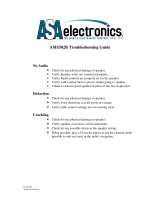
• Read all the safety and operating instructions before con-
necting or using this unit.
• Retain this notice and the owner’s manual for future refer-
ence.
• All warnings on the unit and in its operating instructions
should be adhered to.
• All operating and use instructions should be followed.
• Do not use this unit near water. For example, near a bathtub,
washbowl, kitchen sink, laundry tub, in a wet basement, or
near a swimming pool.
• The unit should be installed so that its location or position
does not interfere with its proper ventilation. For example,
it should not be situated on a bed, sofa, rug, or similar sur-
face that may block the ventilation openings; or placed in a
built-in installation, such as bookcase or cabinet, that may
impede the fl ow of air around its heatsinks or through its
ventilation openings.
• The unit should be situated away from heat sources such as
radiators, heat registers, stoves, or other devices (including
other amplifi ers) that produce heat.
• The unit should be connected to a power supply outlet only
of the voltage and frequency marked on its rear panel.
• The power supply cord should be routed so that it is not
likely to be walked on or pinched, especially near the plug,
convenience receptacles, or where the cord exits from the
unit.
• Clean unit only as recommended in its instruction manual.
• The power supply cord of the unit should be unplugged from
the wall outlet when it is to be unused for a long period of
time and during electrical storms.
• Care should be taken so that objects do not fall, and liquids
are not spilled, into the enclosure through any openings.
• This unit should be serviced by qualifi ed service personnel
when:
a. The power cord or the plug has been damaged; or
b. Objects have fallen, or liquid has been spilled, into the
unit; or
c. The unit has been exposed to rain, or liquids of any
kind; or
d. The unit does not appear to operate normally, or exhib-
its a marked change in performance; or
e. The device has been dropped, or the enclosure dam-
aged.
WARNING
TO REDUCE THE RISK OF FIRE OR ELECTRIC SHOCK, DO NOT
EXPOSE THIS UNIT TO RAIN OR MOISTURE.
AVERTISSEMENT
AFIN D’ÉVITER TOUT RISQUE D’INCENDIE OU D’ÉLECTROCUTION,
NE PAS EXPOSER CET APPAREIL À LA PLUIE NI À L’HUMIDITÉ.
CAUTION
TO PREVENT ELECTRIC SHOCK DO NOT USE THIS POLARIZED
PLUG WITH AN EXTENSION CORD, RECEPTACLE OR OTHER
OUTLET UNLESS THE BLADES CAN BE FULLY INSERTED TO PRE-
VENT BLADE EXPOSURE.
ATTENTION
POUR PRÉVENIR LES CHOCS ÉLECTRIQUES NE PAS UTILISER
CETTE FICHE POLARISÉE AVEC UN PROLONGATEUR, UNE PRISE
DE COURANT OU UNE AUTRE SORTIE DE COURANT, SAUF SI LES
LAMES PEUVENT ÊTRE INSÉRÉES À FOND SANS EN LAISSER
AUCUNE PARTIE À DÉCOUVERT.
THERE ARE NO USER SERVICEABLE PARTS IN THIS PRODUCT.
DO NOT ATTEMPT SERVICING OF THIS UNIT YOURSELF. REFER
SERVICING TO QUALIFIED SERVICE PERSONNEL.
CAUTION POWER LINES
Any outdoor antenna must be located away from all power lines.
OUTDOOR ANTENNA GROUNDING
If an outside antenna is connected to your tuner or tuner/pre-
amplifi er, be sure the antenna system is grounded so as to pro-
vide some protection against voltage surges and built-up static
charges. Section 810 of the National Electrical Code, ANSI/NFPA
No. 701984, provides information with respect to proper ground-
ing of the mast and supporting structure, grounding of the lead-in
wire to an antenna discharge unit, size of grounding conductors,
location of antenna discharge unit, connection to grounding elec-
trodes, and requirements for the grounding electrode.
a. Use No.10 AWG (5.3 mm2) copper, No.8 AWG (8.4 mm2) alu-
minum, No.17 AWG (1.0 mm2) copper clad steel or bronze
wire, or larger, as a ground wire.
b. Secure antenna lead-in and ground wires to house with
stand-off insulators spaced from 46 feet (1.221.83 m) apart.
c. Mount antenna discharge unit as close as possible to where
lead-in enters house.
d. Use jumper wire not smaller than No.6 AWG (13.3 mm2) cop-
per, or the equivalent, when a separate antenna grounding
electrode is used. See NEC Section 810-21 (j).
EXAMPLE OF ANTENNA GROUNDING AS PER NATIONAL ELEC-
TRICAL CODE INSTRUCTIONS CONTAINED IN ARTICLE 810. RA-
DIO AND TELEVISION EQUIPMENT.
NOTE TO CATV SYSTEM INSTALLER
This reminder is provided to call the CATV system installer’s at-
tention to Article 82022 of the National Electrical Code that pro-
vides guidelines for proper grounding and, in particular, specifi es
that the cable ground shall be connected to the grounding system
of the building, as close to the point of cable entry as practical.
NOTE TO AUDIO SYSTEM INSTALLER
WHENEVER CONNECTIONS TO OR FROM THE GFA-555SE ARE BEING
MADE, BE CERTAIN THAT THE AC ON/OFF SWITCH OF THE AMPLI-
FIER IS IN THE OFF POSITION, THE AC CORD OF THE AMPLIFIER IS
DISCONNECTED FROM THE AC WALL OUTLET AND THAT ALL AS-
SOCIATED COMPONENTS ARE OFF. Always make certain that the
amplifi er is disconnected from the AC outlet for at least fi ve min-
utes to ensure its fi lter capacitors are discharged before mak-
ing connections to and from the amplifi er. Failure to heed this
precaution may result in damage to the loudspeaker(s) and/or the
amplifi er which is not covered by the Warranty.
4
THE FOLLOWING PRECAUTIONS AND SAFETY INSTRUCTIONS
ARE REQUIREMENTS OF ETL AND ETL
C
SAFETY REGULATIONS

















